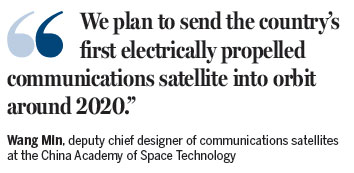
China is developing electrically propelled satellites and plans to send the first one into space around 2020, according to a senior satellite designer at the China Academy of Space Technology.
"We have commanded the most advanced propulsion technology through our own research, following the United States, Russia, the European Space Agency and Japan. We plan to send the country's first electrically propelled communications satellite into orbit around 2020, providing a broadband communication data transmission service to China and neighboring regions," said Wang Min, deputy chief designer of communications satellites.
China will launch a hybrid propulsion communications satellite at the end of next year. The electric propulsion system will also be used in China's future space station, Wang said.
Electric propulsion is regarded as one of the top cutting-edge space technologies, because it can send spacecraft into deep space at a lower cost than other forms of propulsion.
The biggest advantage of the electric thruster is that it uses just 10 percent of the propellant required by traditional chemical propulsion systems. A typical chemically propelled communication satellite weighing 5 metric tons contains about three tons of fuel. A similar satellite with an electric propulsion system would only require 300 kilograms of propellant.
"The benefit is obvious," Wang said. "The weight of the satellite can be substantially decreased, so a rocket could send two satellites into orbit at the same time. Alternatively, a smaller rocket could be used to carry the satellite, thus saving on launch costs. The reduction in the weight of fuel would also allow for more equipment on the satellite to give it more functions."
Electric propulsion also allows a satellite's life span to be extended. No longer is it restricted by the amount of fuel it carries. The designed life span of a communications satellite would extend from the current 15 years to 20 years, Wang said.
The main disadvantage of electric propulsion is that its thrust is low, so it cannot be used on carrier rockets or spacecraft that need a quick orbit entry.
Zhou Zhicheng, an expert on communications satellites at the academy, said China's electrically powered spacecraft propulsion technology is well developed and will be adopted for the nation's communications satellites, high Earth orbit remote sensing platforms as well as deep-space exploration vehicles.
The international space community has launched more than 50 electrically propelled spacecraft since the 1960s.
China has tested the functions of several experimental electric thrusters on two Shijian 9 satellites launched in October 2012, earlier reports said.
The electric thrusters developed by Wang's team generate up to 5 kilowatts. The academy plans to develop a 50-kilowatt electric thruster by 2020. An array of 40 electric thrusters of 50 kilowatts could send a 300-ton spacecraft to Mars in 200 days, according to the academy.
zhaolei@chinadaily.com.cn

(China Daily 06/17/2015 page3)








